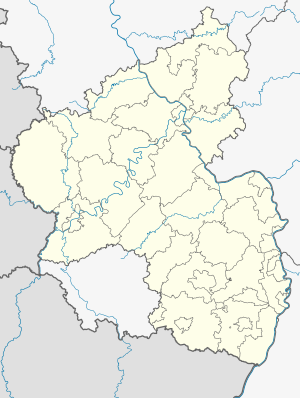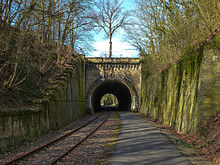Meisenheim tunnel
| Meisenheim tunnel | ||
|---|---|---|
|
Meisenheim tunnel
|
||
| use | Railway tunnel , handcar, bike and hiking trails | |
| traffic connection | Glantalbahn | |
| place | Meisenheim | |
| length | 70 m | |
| Number of tubes | 1 | |
| construction | ||
| Client | Society of the Palatinate Northern Railways | |
| start of building | 1894 | |
| business | ||
| release | 1896 | |
| location | ||
|
|
||
| Coordinates | ||
| North portal | 49 ° 42 ′ 20 " N , 7 ° 40 ′ 10" E | |
| South portal | 49 ° 42 ′ 18 " N , 7 ° 40 ′ 10" E | |
The Meisenheim tunnel is, along with the Elschbach tunnel and the Kinnsfel tunnel, one of a total of three tunnels on the Glantalbahn, which has been closed for regular rail traffic since 1996 . On this route it is the shortest, the longest operated and the only one that still has a track. Tourist trolley transport has been operated on it since 2000. A cycling and hiking trail runs next to the platform.
Geographical location
The tunnel is located in the district of Meisenheim , after which it was named, at kilometer 84.5.
history
Initiatives, planning and construction
After the first initiatives aimed at a railway connection to Meisenheim had failed, a state treaty was signed between Bavaria and Prussia on October 28, 1891 . He planned to tie the Lautertalbahn Kaiserslautern - Lauterecken , which had been in operation since 1883, along the Glan to Staudernheim . The corresponding planning was completed in the spring of 1891. Although the line north of Lauterecken touched Prussian territory several times, it was built by the Palatinate Northern Railways company since autumn 1894 . Since a strategic railway line along the Glans from Homburg to Bad Münster was already planned at that time , it was built as the main line in accordance with military requirements .
Immediately south of the Meisenheim settlement area, a mountain slope had to be overcome. For this purpose, an approximately 700 meter long cut and a 70 meter long tunnel were built. The latter is located near the castle church . During the work, 150,000 cubic meters of rock were removed in this area. With the opening of the Lauterecken – Odernheim section in October 1896, the “Meisenheimer Tunnel” was opened to traffic, initially - like the entire line - as a single track.
Further development up to decommissioning (1898–1996)
At the same time the plans for the expansion of the existing line between Lauterecken and Odernheim were concretized in accordance with military requirements. This meant the double-track expansion including a widening of the Meisenheim tunnel. Both tunnel portals received retaining walls. After several test drives had taken place in April, the Glantalbahn was opened continuously on May 1, 1904.
On October 13, 1944, during World War II , an ammunition train was parked in the tunnel. For this reason, Meisenheim was bombed, killing people and affecting many residential buildings.
After the Odernheim – Bad Münster section, including the Kinnsfelstunnel, was closed in 1961 and dismantled in the following two years, the Meisenheimer tunnel could only be reached from the north from the direction of Staudernheim. In the mid-1960s, the second track on the Glantalbahn between Altenglan and Odernheim was gradually dismantled ; since then there has only been one track in the tunnel.
In the following two decades, the line increasingly lost its importance, so it was downgraded to a branch line between Glan-Münchweiler and Odernheim in September 1985. Just a year later, passenger traffic between Lauterecken and Staudernheim was discontinued . On February 27, 1993, freight traffic between Lauterecken and Meisenheim ended , meaning that regular traffic through the tunnel no longer took place. The section between Lauterecken and Staudernheim was closed on July 1, 1996.
Development since 1996
To prevent the line from being dismantled , students at the University of Kaiserslautern came up with a plan to set up a railroad trolley service on the Glantalbahn between Altenglan and Staudernheim . Among the supporters of this project was the Kuseler district administrator Winfried Hirschberger ; he finally achieved it in 2000. The Meisenheim tunnel has been part of the draisine railway since 2000.
From 2001 to 2006 the so-called " Glan-Blies-Weg " was gradually opened on large parts of the dismantled second track . After it was completed between the Meisenheim and Raumbach stations, it was extended both north and south in the following years. Since then, it has been running on the route of the dismantled second track parallel to the track for the draisines through the tunnel.
literature
- Hans-Joachim Emich, Rolf Becker: The railways on Glan and Lauter . Self-published, Waldmohr 1996, ISBN 3-9804919-0-0 .
- Fritz Engbarth: From the Ludwig Railway to the Integral Timed Timetable - 160 Years of the Railway in the Palatinate . 2008 ( zspnv-sued.de [PDF; 4.1 MB ; accessed on December 1, 2012]).
Web links
Individual evidence
- ↑ a b eisenbahn-tunnelportale.de: Pictures of the route: 3281 (KBS 671, trolley traffic, cycle path, closed / KBS 272d) . Retrieved January 15, 2013 .
- ↑ Hans-Joachim Emich, Rolf Becker: The railways to Glan and Lauter . 1996, p. 19th f .
- ↑ Hans-Joachim Emich, Rolf Becker: The railways to Glan and Lauter . 1996, p. 20th f .
- ↑ Hans-Joachim Emich, Rolf Becker: The railways to Glan and Lauter . 1996, p. 21st ff .
- ↑ Hans-Joachim Emich, Rolf Becker: The railways to Glan and Lauter . 1996, p. 50 .
- ↑ Hans-Joachim Emich, Rolf Becker: The railways to Glan and Lauter . 1996, p. 59 f .
- ↑ Hans-Joachim Emich, Rolf Becker: The railways to Glan and Lauter . 1996, p. 64 .
- ↑ Fritz Engbarth: From the Ludwig Railway to the Integral Timed Timetable - 160 Years of the Railway in the Palatinate . 2007, p. 101 .
- ↑ achim-bartoschek.de: Railway route cycling - details - Germany> Rhineland-Palatinate> south of the Nahe - RP 3.08 Glan-Blies cycle path: section Staudernheim - Waldmohr . Retrieved December 29, 2012 .



